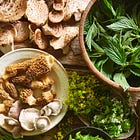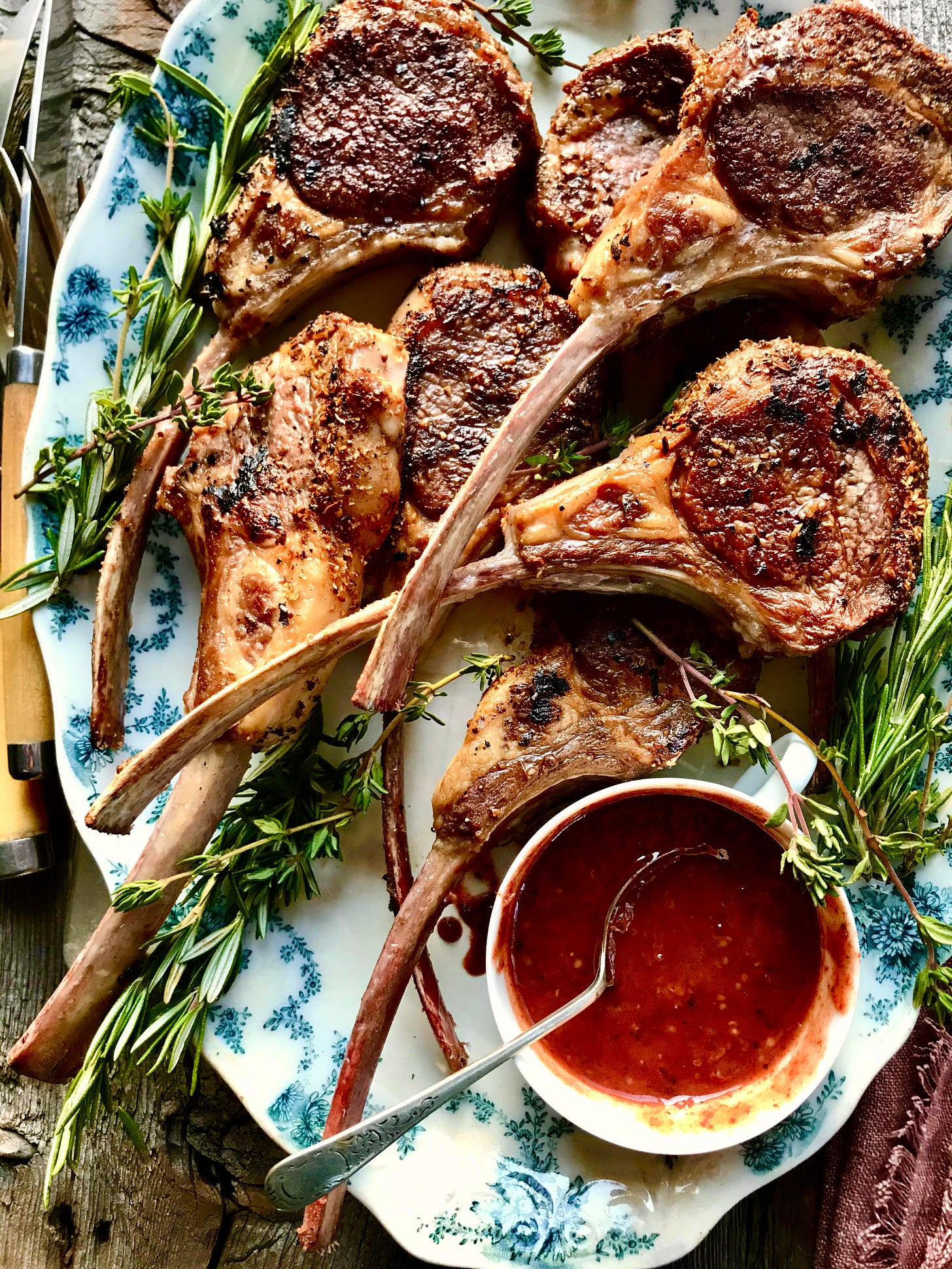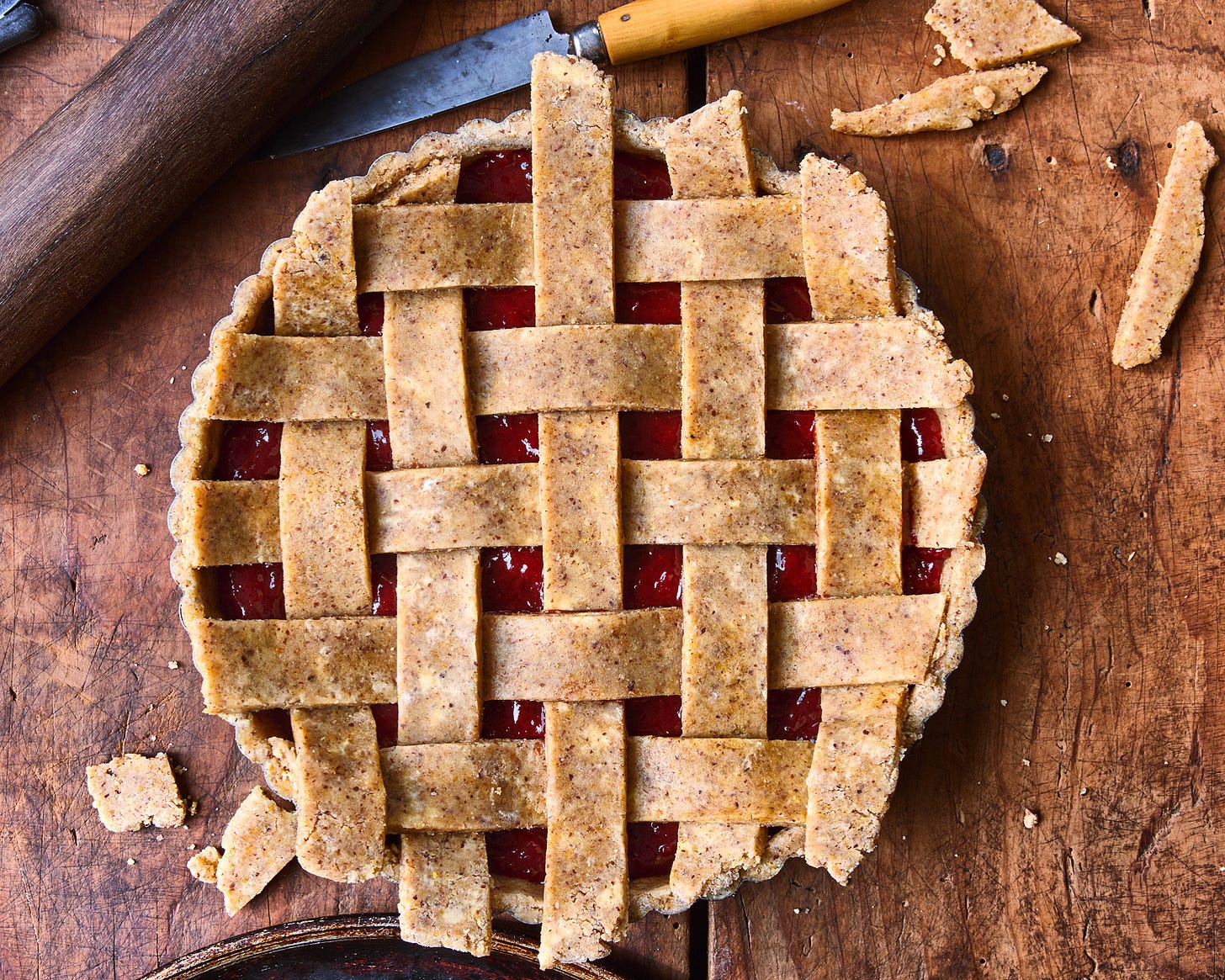✴︎ If you enjoy this post, thank you so much for clicking the ♥️, restacking it, or sharing it with another foodie or foraging fan. That little bit really helps! ALSO: please don’t hesitate to send me a direct message here on Substack to make future recipe requests.✴︎
Today’s deep dive into wild berries is free to all subscribers. Your email will cut it short, so click through to read the full thing. Feel free to hit the share button to help others find Stories from Catbird Cottage!
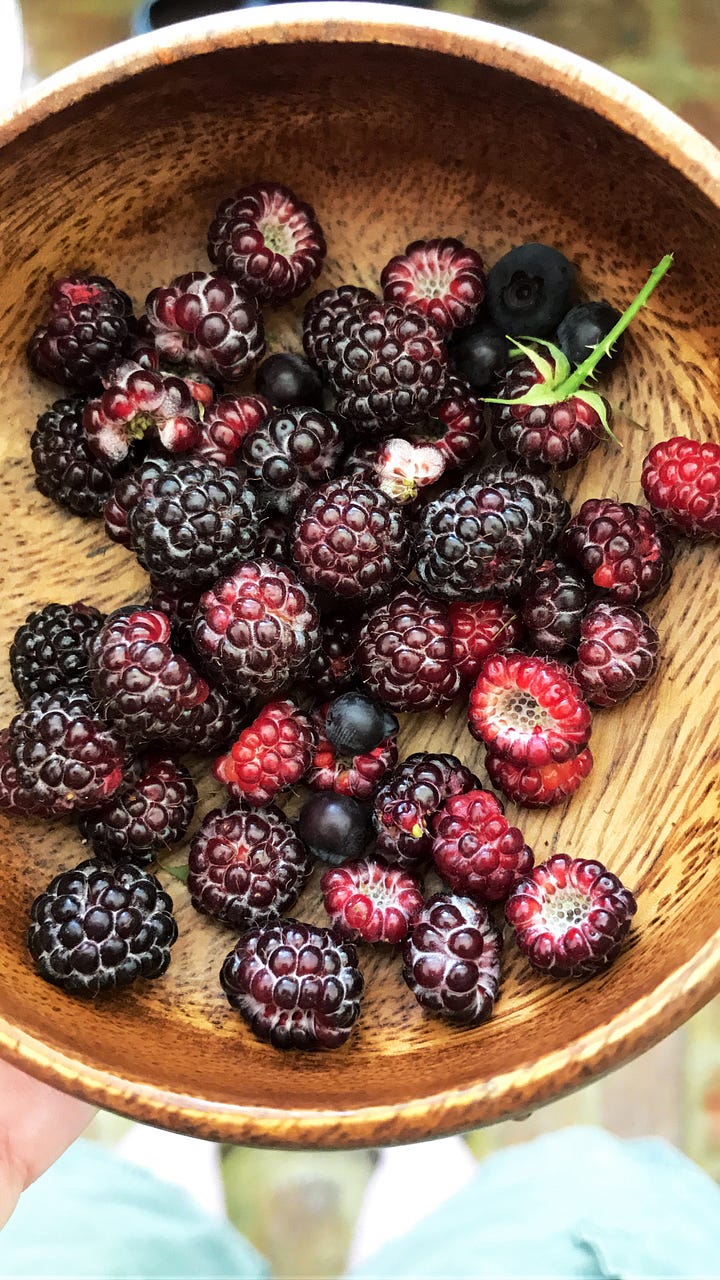
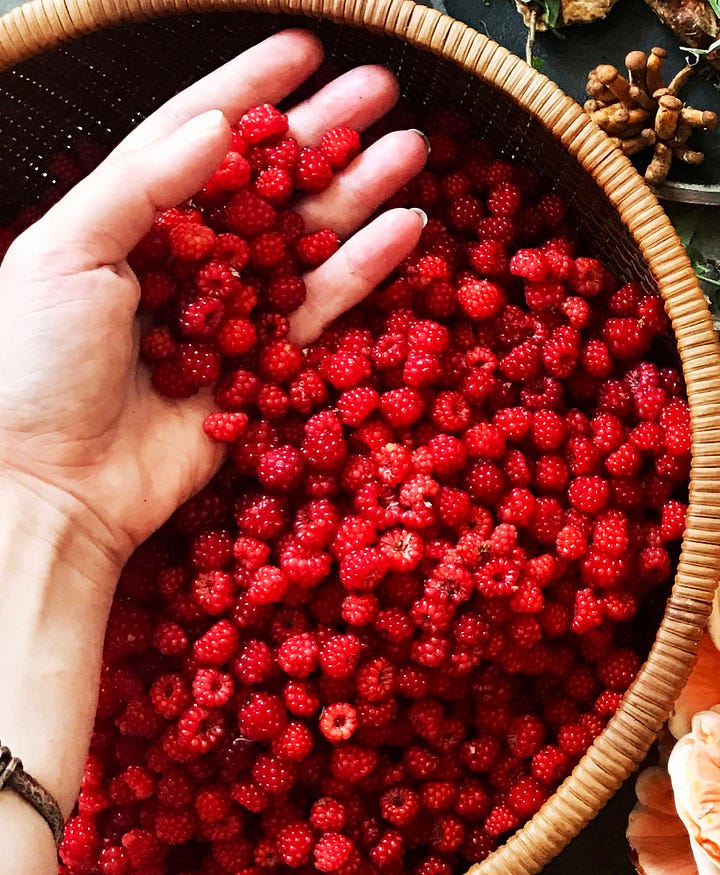
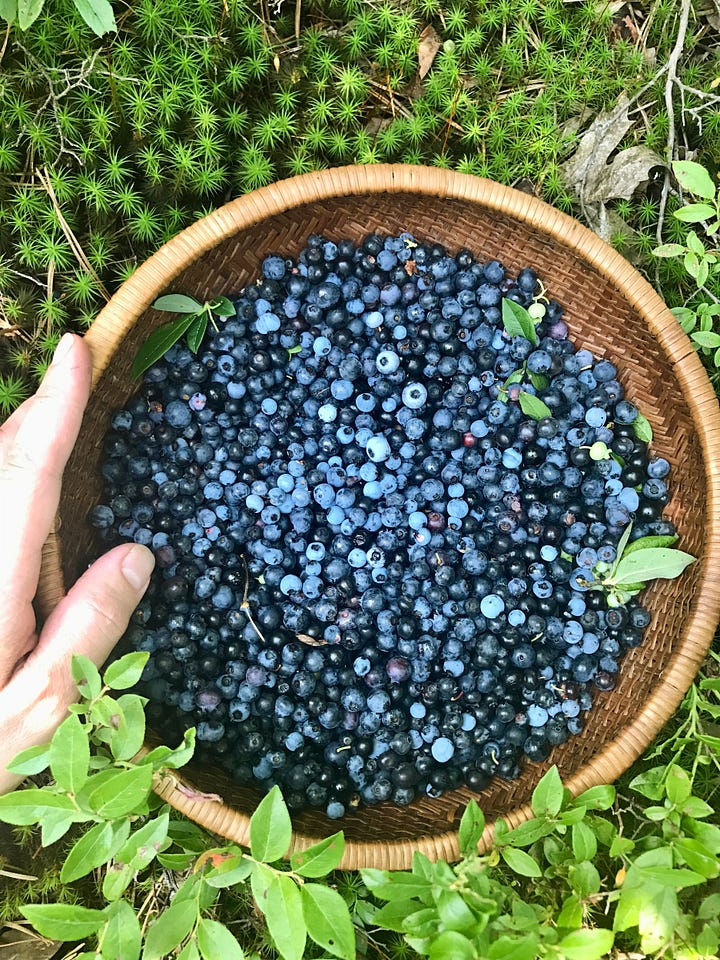
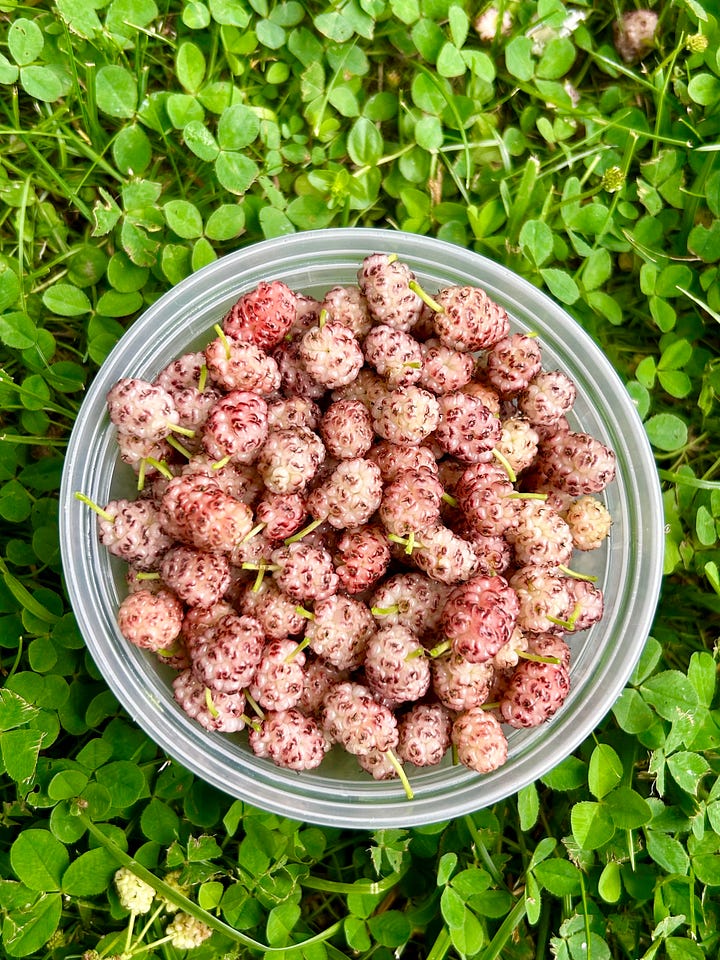
Welcome to today’s special installment of Stories from Catbird Cottage! It’s the perfect time to share with you a second chapter on wild foods. Today, I’ll take you through a tour of some of my favorite wild berries so you can properly identify, harvest, and enjoy them at home.
If you haven’t seen my debut primer on foraging, check out that deep dive, below.
It’s filled with all kinds of delicious, nutrient-dense, *free* food, growing all around you.
Disclaimer: As always, never accept anything you read on the internet without verifying it for yourself, either with a local expert, or several publications. Before I eat anything, I cross-reference with at least 3 reliable sources. I have found this to be a remarkably good method to ensure my safety when foraging.
Now is the time of abundance. This year has been very much that on the wild landscape, and now, berry season is upon us. Everywhere, berries are ripening, just waiting to be harvested and folded into pancakes, cooked down into preserves and all manner of things, to bring out even more of their sweet juiciness.
There is a remarkable article titled The Serviceberry by Robin Wall Kimmerer I read a while back that feels particularly appropriate to include here today. A story of “abundance” at a time when livelihoods are being snatched away. Her story of economies of abundance might very well be my favorite economies, built on mutual aid. It is a longer form essay - I highly recommend listening to her read it, and taking her message with you as you set out to forage.
✤ My favorite wild berries ✤
Autumn olives - Elaeagnus umbellata
Blackberries - Rubus allegheniensis
Black raspberries - Rubus occidentalis
Blueberries, highbush and lowbush - Vaccinium angustifolium and V. corymbosum
Dewberries - Rubus flagellaris
Elderberries - Sambucus canadensis
Huckleberries - Gaylussacia baccata
Mulberries - Morus alba
Purple-flowered Raspberries - Rubus odoratus
Serviceberries - Amelanchier spp
Wineberries - Rubus phoenicolasius
Autumn olives
Autumn olives are a sparkly red berry containing a small seed, which grows from hanging stems on tall shrubs. This shrub, also known as Japanese silverberry, oleaster, or autumnberry originated in Asia and can grow as tall as sixteen feet. The curvy-edged silvery leaves are leathery, similar to actual olive trees, which may be how they got their name.
The shrub was originally brought to the United States in the late 1800s to mitigate against soil erosion, but because birds and bears love the berries too, they help spread the seeds rampantly. Since autumn olive trees fare well in drought and poor soil conditions, they have taken over in some areas: groves of trees can be found in my region, pushing out native varieties such as serviceberries, hazelnuts, native plums, and hawthornes, who grow in similar habitats. For the forager, an abundance of berries in a single location is good news. But do not plant an autumn olive tree. They are considered invasive by both homeowners as well as by the US government.
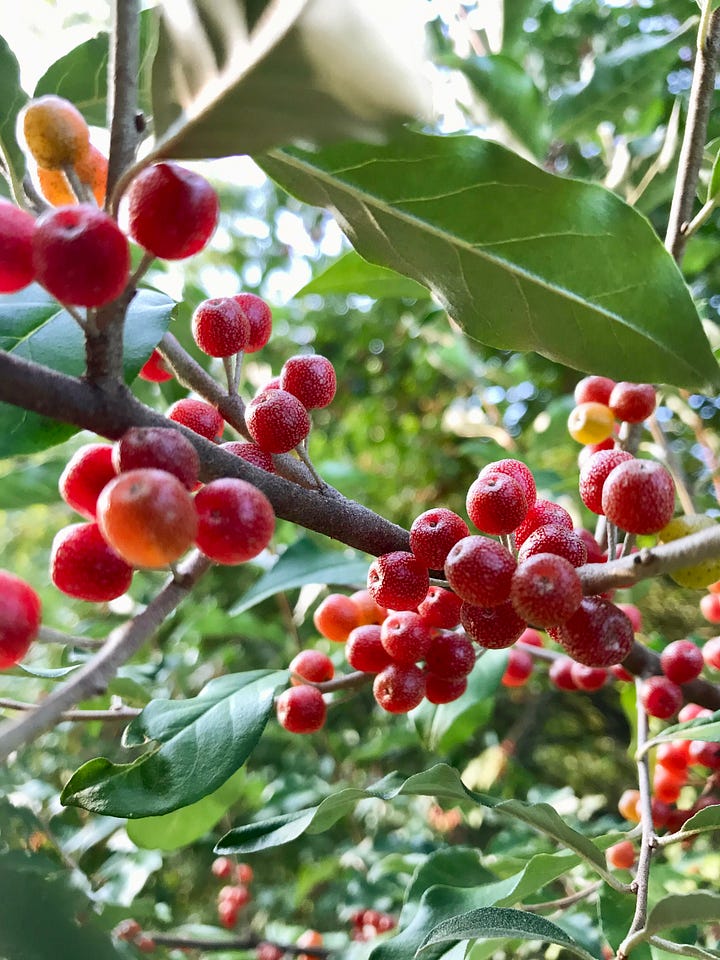
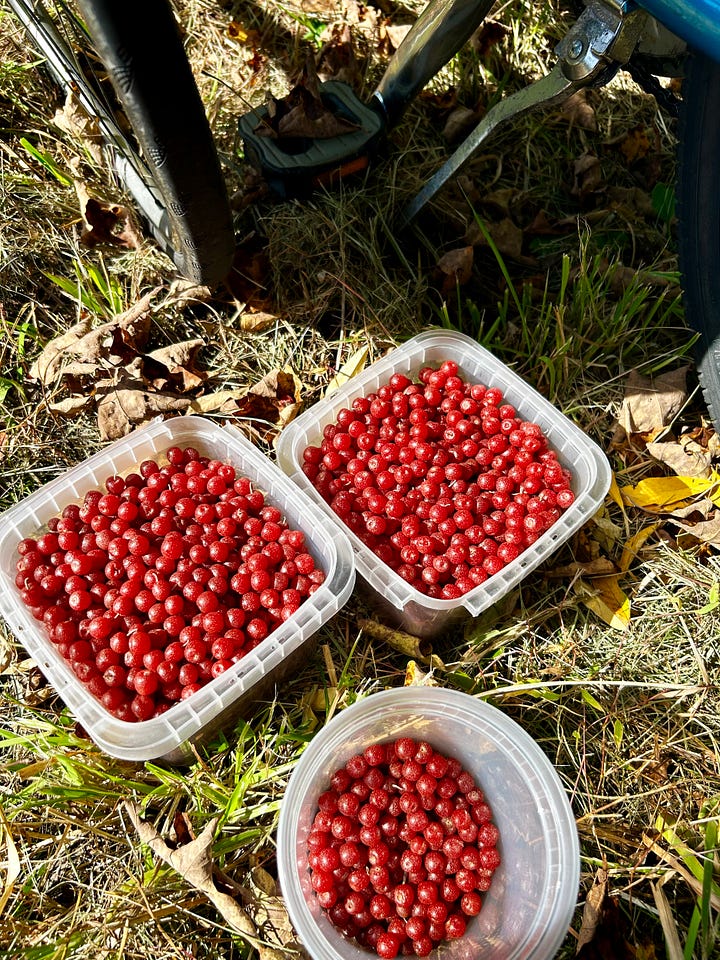
They taste like lingonberry-meets-cranberry, ripening August through October in the Hudson Valley. The sweet-tart, slightly tannic berries are excellent eaten raw, made into jam, sauces (sweet or savory, such as mostarda), wine, and fruit leather. There is more lycopene in autumn olives than tomatoes! They also possess other health-boosting carotenoids. Pairing an autumn olive sauce with grilled or roasted meat is a good idea, not only because the tangy sweetness blends well with the rich flavors, but also because the fat in the meat magnifies the benefits of the lycopene.
Lamb chops with autumn olive mostarda
To harvest autumn olives, hold a berry-laden branch over a large paper
shopping bag with handles, looped over one wrist (or a bucket fashioned similarly). Gently stroke the branches as if you were playing a harp, freeing them from their stems, allowing the berries to fall into the bag. Berries should be plump and fully red when you harvest.
In my book, there’s an excellent autumn olive jam recipe and I cannot recommend it enough. When made in the called-for quantity, the resulting jam is curd-like in texture. It pairs excellently on a grazing board with with a triple-cream or blue cheese, and makes an equally luscious filling in the spiced Linzer tart, on page 229. To ensure you do not start your own autumn olive population after foraging, do not compost the pomace-seed mixture or distribute them elsewhere: to the trash bin they must go.
Blackberries
My first time picking wild blackberries was on a trip to a remote coastal region in Maine, then making the *best pie ever* with the harvest. There really is something magical to making a dish imbued with nostalgia from a labor-of-love experience, hand-picking innumerable fruits in the wild, nature a sensory presence all around you.
Blackberries are a quintessential wild berry. The brambles are one of the thorniest of wild berries, growing in arching canes up to 13 feet long along the edges of woodlands, hedgerows, scrublands, and even urban areas. The ridged branches can sometimes grow into dense briar patches - wear long sleeves and be careful of the thorns!
Blackberries have white five-petalled flowers, and ovate shiny purplish-black fruits that grow in clusters. Sharp-toothed leaves of 3-5 leaflets are arranged alternately on the stem, with pronounced veining on every leaflet. Berries turn from green to red, then finally to black as they ripen. Brambles produce a steady supply of ripe berries from July through August. Pick the darkest fruits, which will come away easily when pulled. (They will also temporarily stain your hands with their inky hue, fyi.)
Blackberries are great made into pies, cobblers, jam, mostarda, syrup, as a topping to possets or chocolate mousse, and just eaten out of hand.
Black raspberries
Ripening right now, black raspberries are also known as black caps, and are a bramble berry native to the eastern US. Shrubs with greater sun exposure will set more fruit, but plants can be found in forests, forest edges, meadows, fields, and disturbed areas. Black raspberry plants aid against soil erosion and provide cover for many animal species. They also attract native bees and provide nesting materials for them. I have multiple thickets on my property in as many environments, as their seeds get dispersed by animals who have eaten the fruits. Their arching branches can take root as well, spreading via runner roots and producing new plants.
The sweet-tart berries are a diminutive member of the bramble family, loved by many bird species, chipmunks and other rodents, and black bears. Their thorny canes are often burgundy-purple (with the newest growth bluish-green), and all are coated in a chalky bloom which can be rubbed off. Similar to blackberry leaves, they grow in palmately compound leaves, 3-5 leaflets are arranged alternately on the stem. The leaflets are toothed and are 3-5 inches long. Black raspberry plants have small white flowers when in bloom. When a black raspberry is harvested, the receptacle stays on the plant and the fruit is hollow, like a thimble.

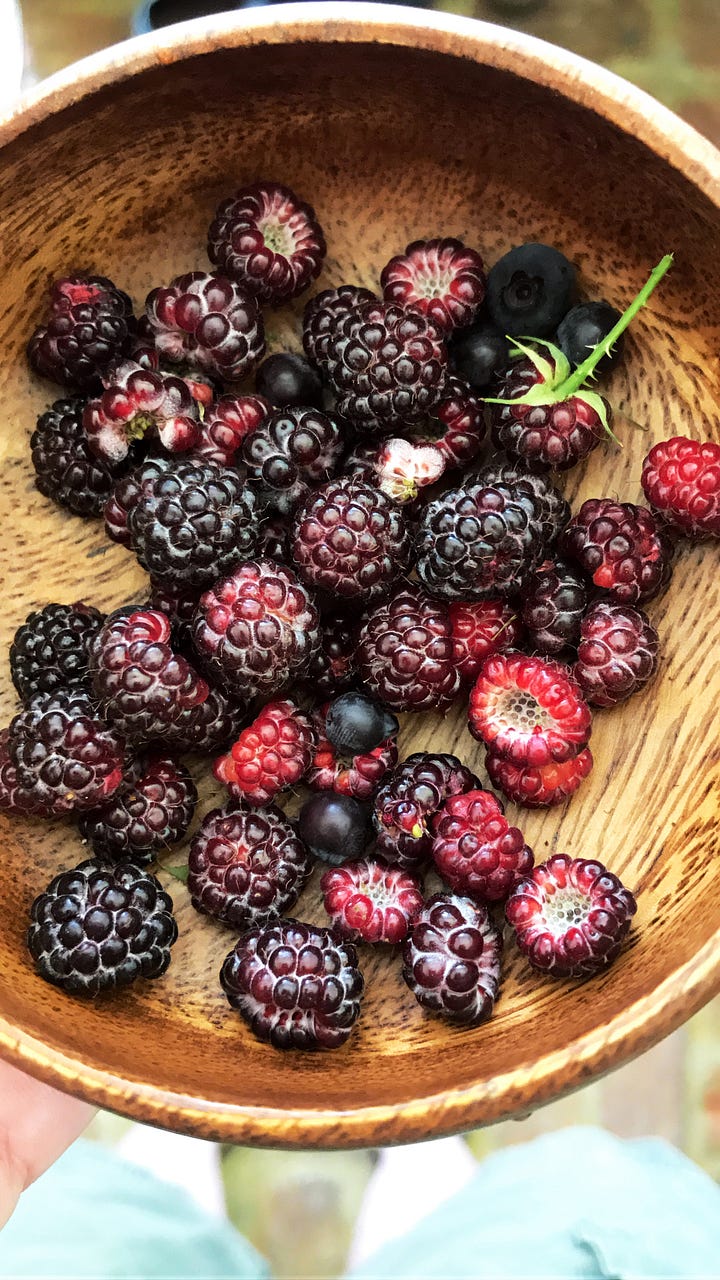
To use black raspberries, make tea from their leaves, use the berries to make jams, syrups, ice cream or sorbet, and pies, or use them fresh on tarts, or to top yogurt, ice cream, and salads.
Black raspberry + bourbon mascarpone-cream tartlets
Blueberries
Wild blueberries are very much a thing and put cultivated blueberries to shame - which dwarf the wild berries in size, but pale in comparison in flavor. Wild blueberries are native shrubs with both highbush and lowbush species. Lowbush blueberries grow up to 18 inches tall. Highbush blueberries grow up to 7 feet tall, and unlike most other berry shrubs, they do not have thorns. Despite being tiny, they have twice the antioxidants of cultivated blueberries, due to a greater concentration in the flavonoid anthocyanin.
Fruits have a five-pointed crown on the underside of the berry; leaves are green and broad with a defined point and turn a scarlet red in the fall. The flowers are small, bell-shaped, and pink or white. They typically ripen mid-July through mid-August here in the Hudson Valley. If you harvest wild blueberries, do so with a friend. Bears also like blueberries but instinctively do not want to be near humans. In company you’re likely to make conversation or other sounds, alerting any bears so no one gets surprised.
Ripe wild blueberries should detach easily from their stems with a gentle roll of your fingers. If you have to pull the fruit off with any force, it’s likely not yet perfectly ripe. Fruit on a single bush ripens over a period of several weeks.
These tiny berries pack a flavorful punch, but be sure to sample from different shrubs, as well as different areas on a plant—not all have the same wonderful flavor - it’s best finding that out before you harvest a container-full.
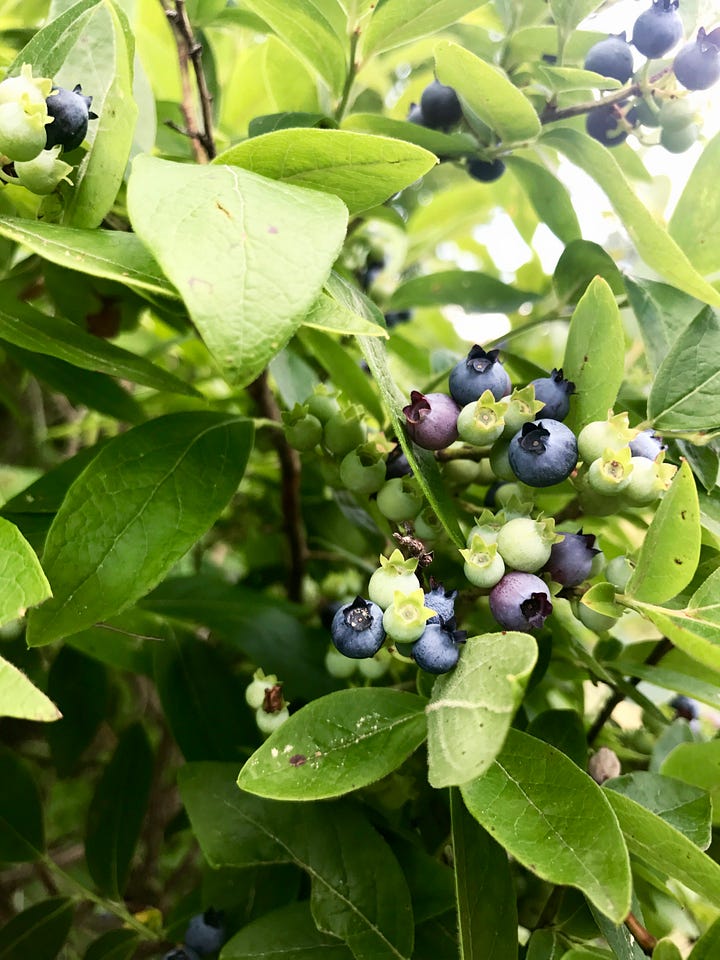
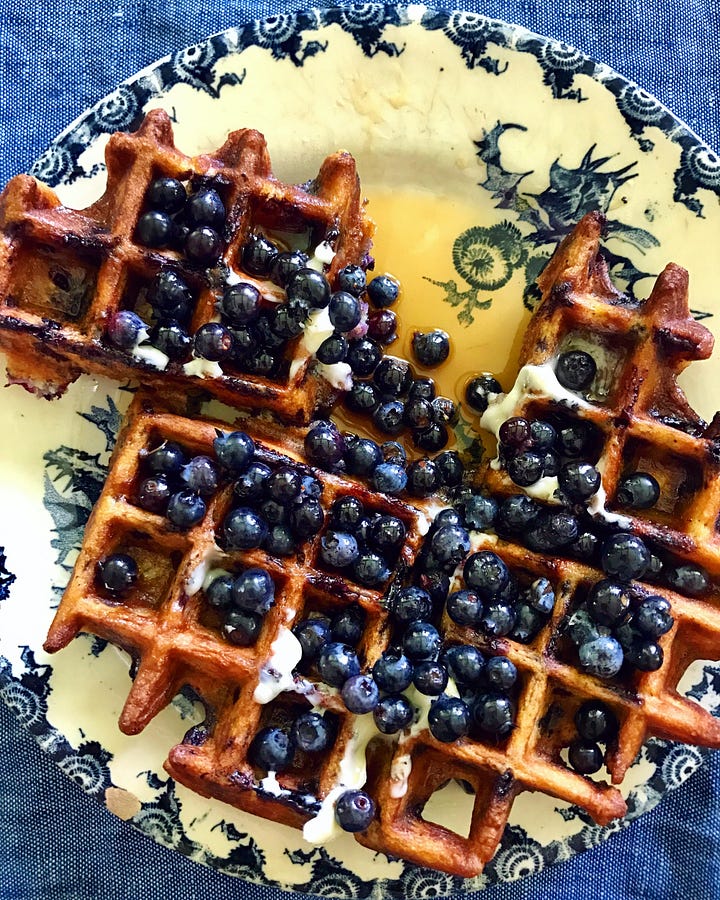
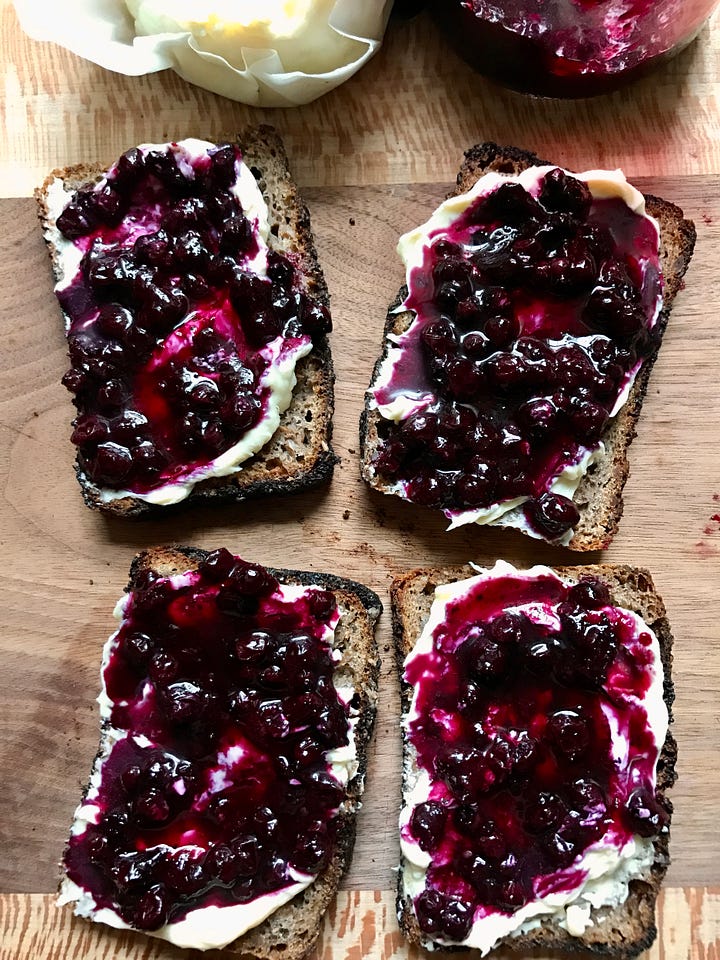
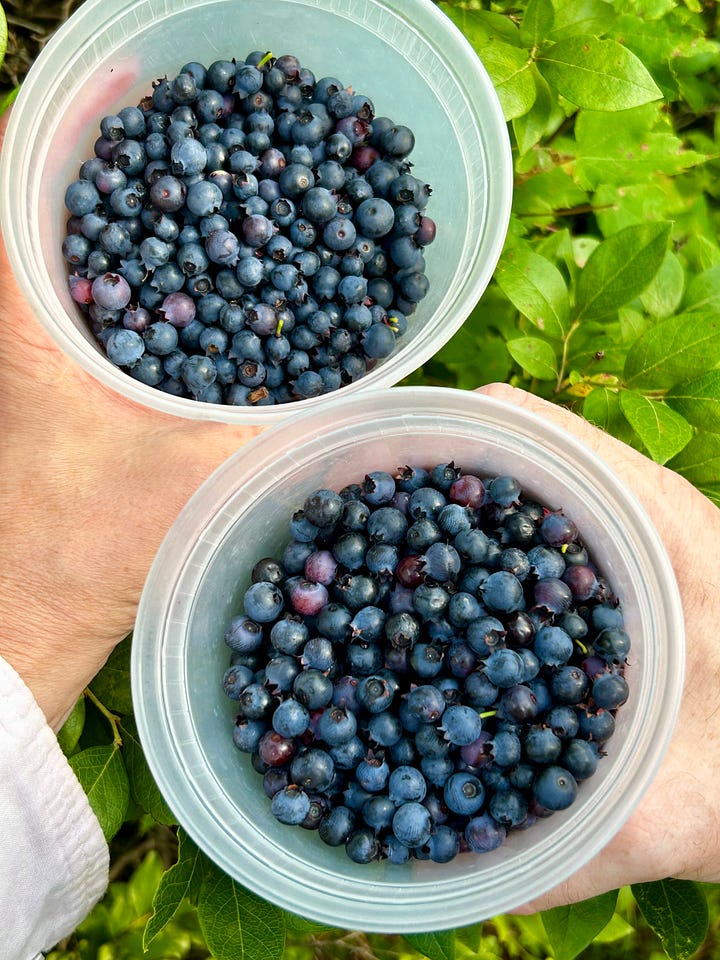
Make compote (there’s a recipe for compote in my book, on page 100) or syrup, eat them on cereals or yogurt, or add them to antioxidant-rich salads. Freeze them in a single layer on a sheet pan and transfer them to a resealable bag, so you can enjoy them once berry season is long gone.
Dewberries
Dewberries are a native plant which grows throughout the eastern half of the United States, in gardens, fields, ditches, prairies, and abandoned pastures. Dewberries grow on stems as single, small fruits, on thin, prickly, trailing, woody vines along the ground. Young stems are green; older stems are brownish and woody, and plants rarely exceed two feet in height. Flowers are white to pink with five petals and multiple stamens, similar to the rose family (of which it is a member). Similar to blackberries, fruits begin green, turn red, and ripen to a shiny black, but dewberries ripen sooner - in July, here in the Hudson Valley. Many types of birds also love dewberries, including catbirds, bluebirds, cedar waxwings, and cardinals, as do raccoons, opossum, and mice, so leave some for nature when you harvest.
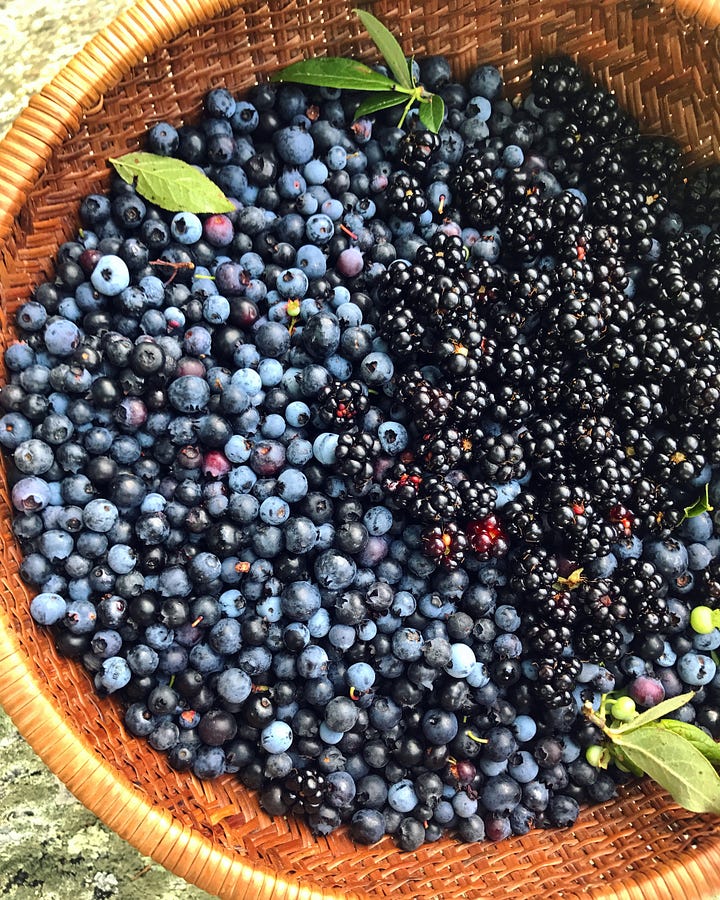
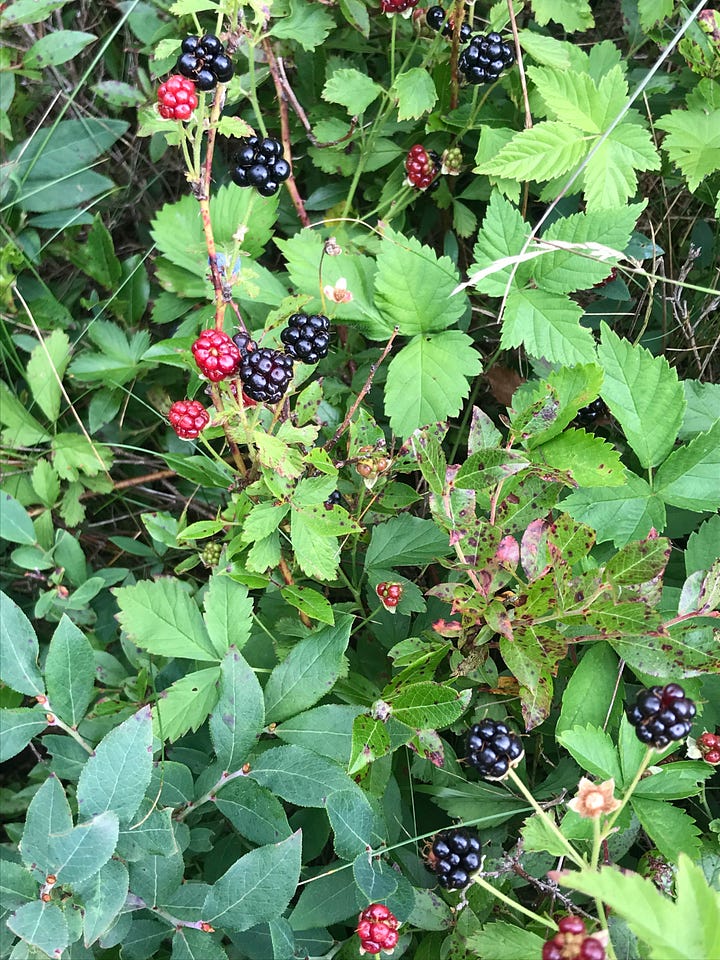

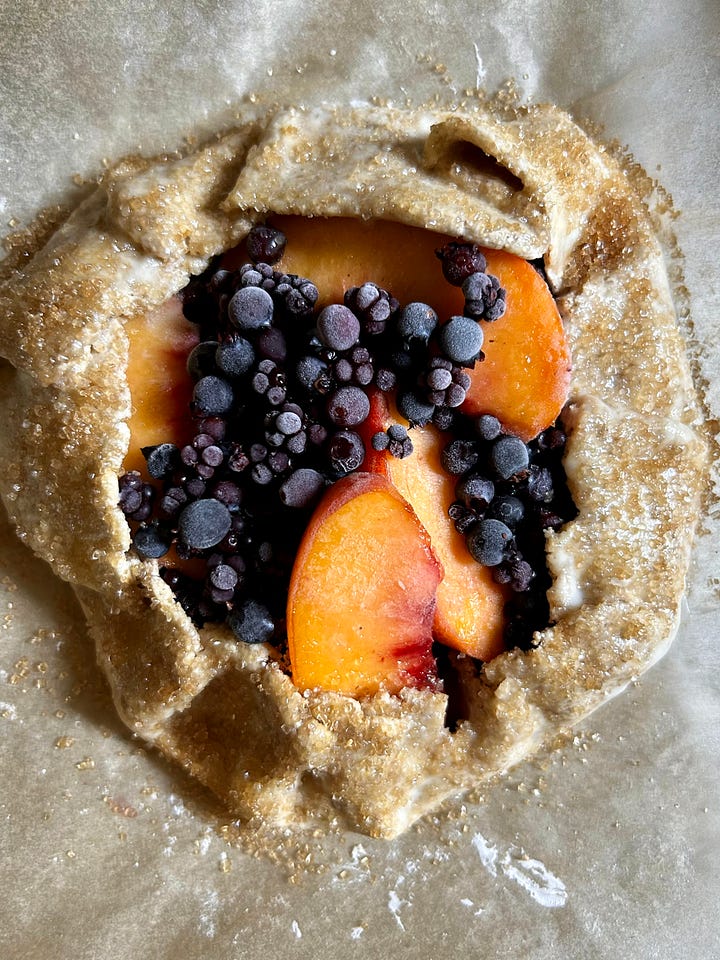
Dewberries are an excellent berry eaten straight from the plant. They can also be prepared as you would blackberries: made into pies or galettes, vinegar or syrup, jam, or to infuse spirits. A dewberry-infused vermouth is a nice way to commemorate summer… Their leaves can also be used for a healing tea.
Elderberries
The elderberry is a perennial shrub native to North and Central America. Its flowers show in midsummer (June and July), then the plant forms purple-black berries in late summer here in the Hudson Valley. Elderberry shrubs grow in sunny locations, along roadsides, in woodland clearings, and along stream banks. I planted a pair of shrubs our second summer at the cottage after we undertook a large landscape project to clear invasive plants. They both have since grown vigorously and are now small trees! They need very little care - though I do keep them behind a fence due to curious deer - and have been a joy to see each season on our hillside.
Shrubs can grow up to 12 feet tall. Their greyish-brown limbs have warty
bumps, and the older bark is brownish-grey with shallow fissures, with thin, platelike scales. Elongated, pointy tip dark green sawtooth leaves grow in opposite pairs, from five to nine leaves per stem. Numerous tiny five-petaled creamy white flowers sit flat on umbrella-shaped clusters (scroll down in this post to familiarize yourself). Berries grow from the flowers into flat, sometimes droopy clusters, up to 10 inches across. Berries are first green in color, then ripen to purple-black. Berries are round and 1⁄8 inch in diameter.
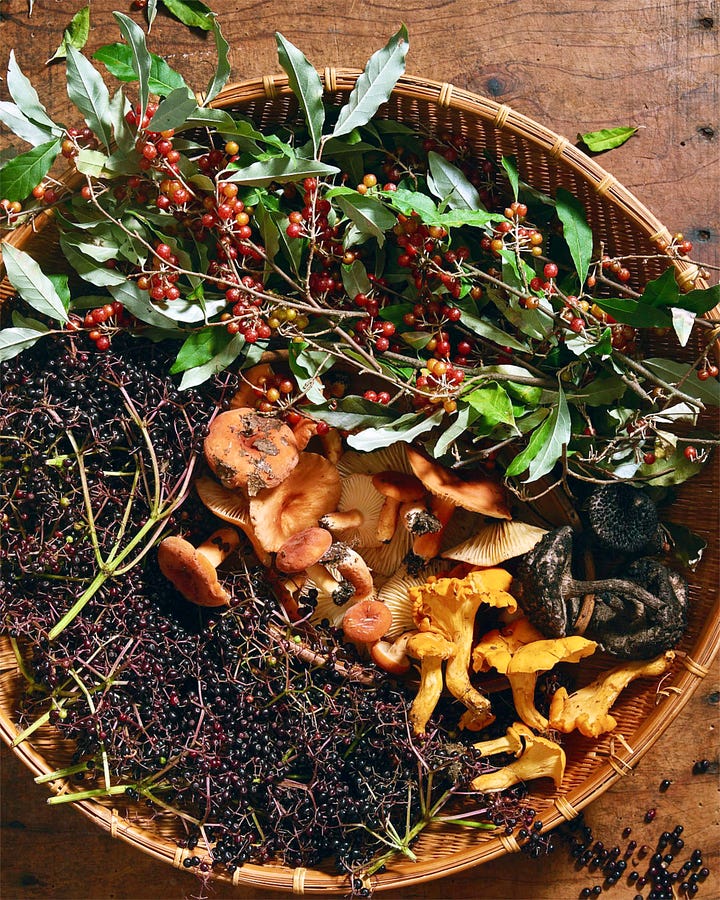
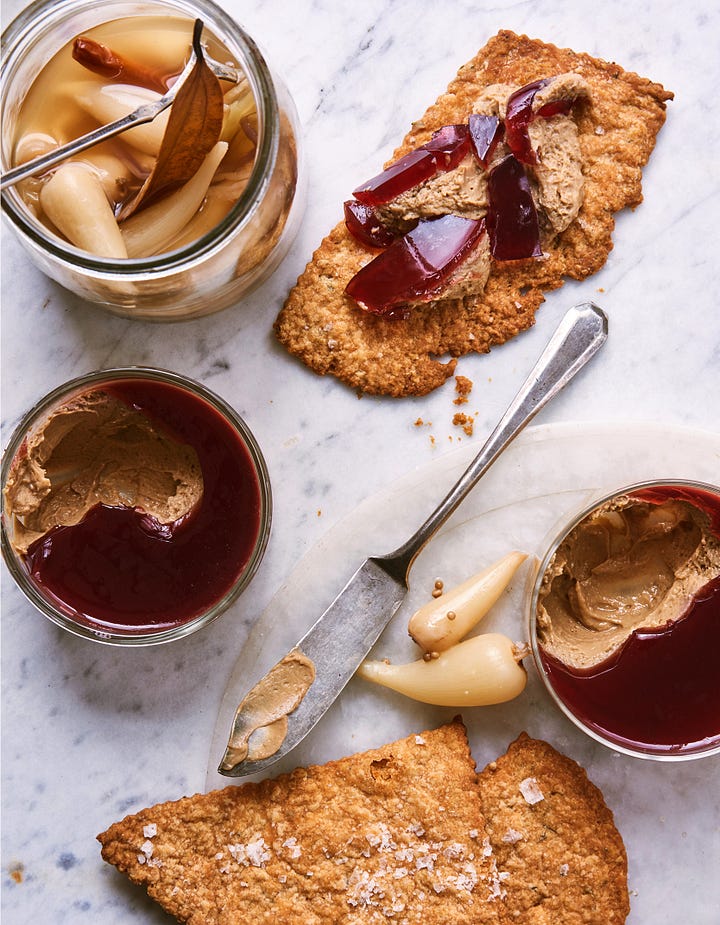
If you have harvested flowers from shrubs, make sure that you’ve left a number of flower heads to develop into fruit: Harvest berry clusters when fruits are shiny and purple-black, plucking individual berries from their stems. Although the flowers and berries are edible, all other parts of this shrub are poisonous, containing toxic calcium oxalate crystals. Only consume the berries when they are fully ripe and only when cooked. Berries can be cooked into a wonderful antioxidant-rich syrup or jam, or made into cordial. I used some of a batch of syrup (which lasts for months stored in the refrigerator) to make a satiny gelée to top chicken liver mousse, as seen above, from my book.
Huckleberries
I won’t ever forget the first time I had huckleberries. It was on my honeymoon, at Al Forno in Providence, RI. They were baked into a beautiful crostata, swimming in a small pool of creme anglaise… it was a delightful end to an epic meal.
Black huckleberry is a native plant which grows from Georgia all the way to Maine, and further north, into Canada. Plants thrive in infertile, acidic soils, similar to wild blueberries. Huckleberry shrubs grow 2-4 feet tall, and their small, oval leaves have smooth edges, alternately arranged on the stems. Tiny pinkish-red bell-shaped flowers emerge months before the berries ripen. Huckleberry plants produce fruits on single stems, rather than compound clusters of fruits. Huckleberry fruits are near black and shiny when fully ripe, 1/4-3/8-inch in size, and contain tiny seeds, which are part of their texture raw (and virtually disappear when cooked). When I forage for wild blueberries, there are also colonies of black huckleberry, and the fruits look very similar. They ripen a little later than wild blueberries so I try to schedule a second jaunt early-to-mid-August to harvest them. Huckleberries contain anthocyanin, powerful superfood antioxidants.
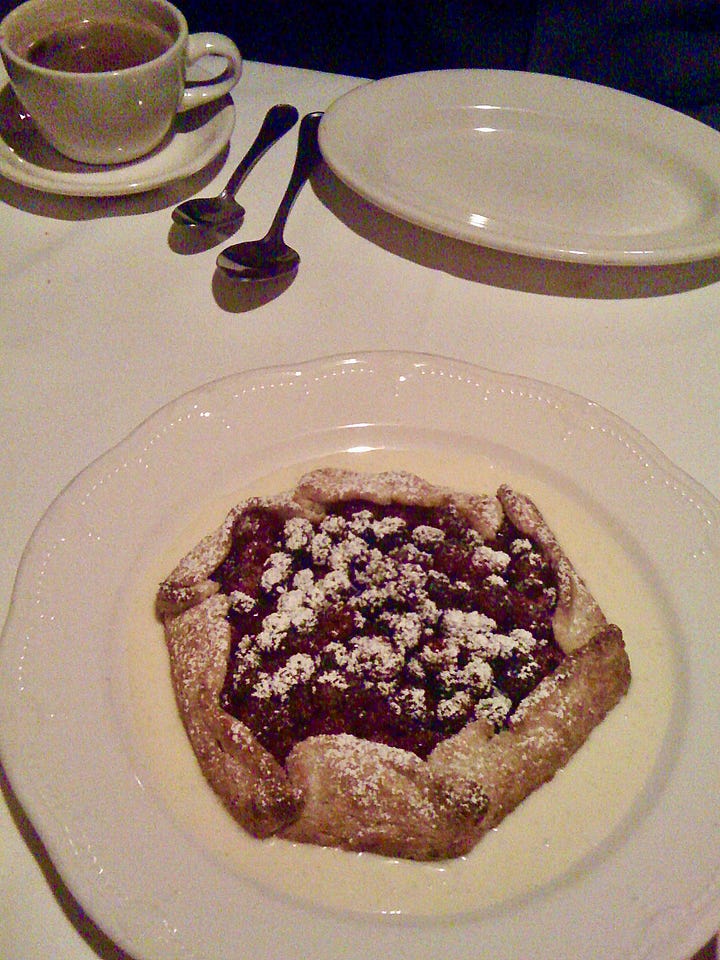
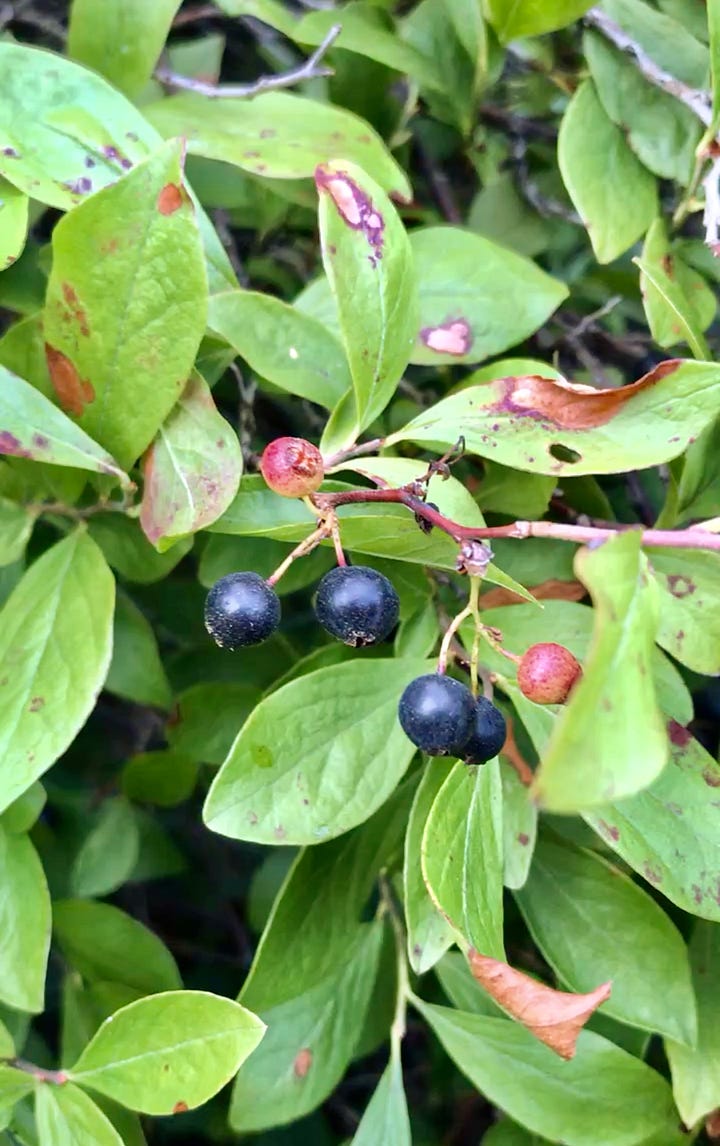
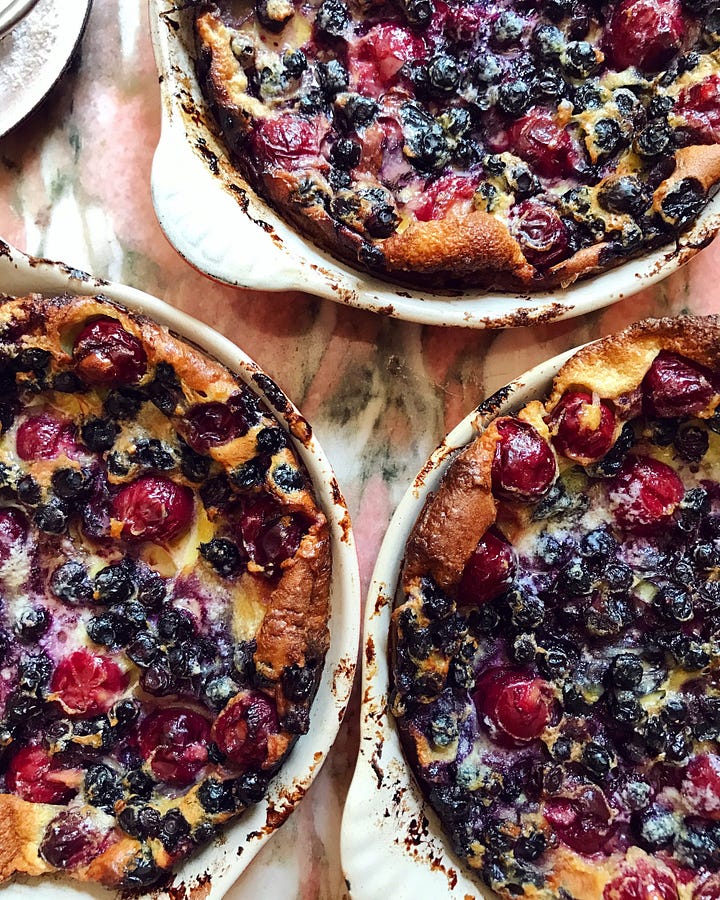
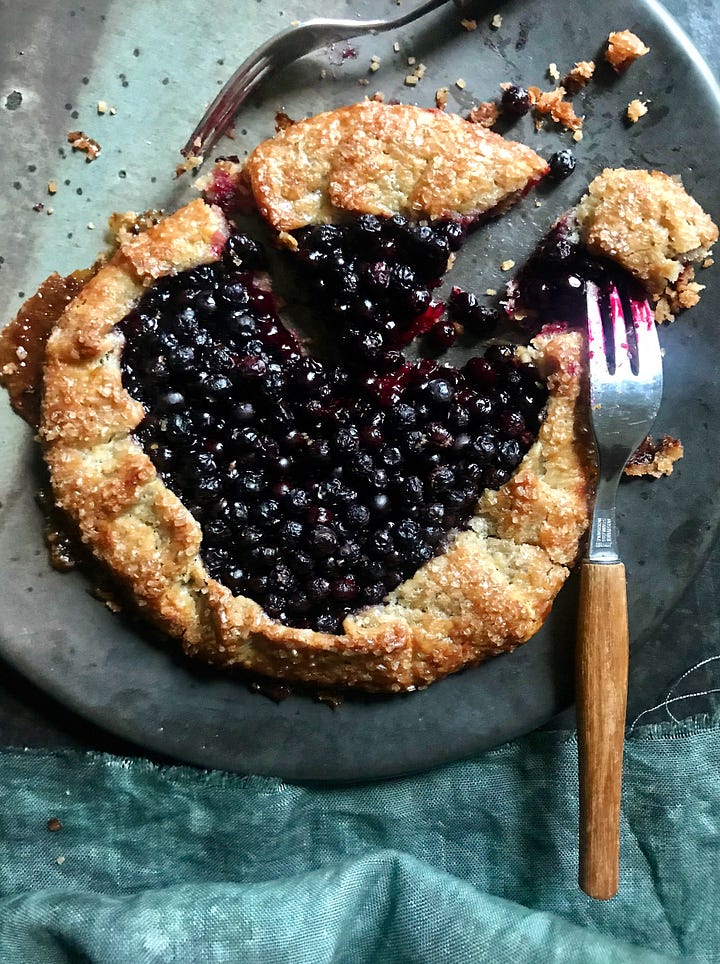
Huckleberries are just as excellent as any berry baked into a crostata or pie. They are also wonderful made into sauce, baked into clafoutis, pancakes, or sweet breads, and I bet they’d be lovely in a crisp or cobbler.
Mulberries
This is another widely known berry, due to their presence in urban areas, along roadsides, backyards, and parks. My childhood included a much sought-after tree, just past the alley behind my house, where I hungrily harvested fistfuls when the season arrived. Mulberry trees grow 30-50 feet tall. Because mulberries are a tree berry they can be foraged in large quantity, as long as you’ve thought ahead to bring a ladder.
Their leaves are alternately arranged, simple, and vary in shape: some are lobed, but those are more common on juvenile shoots than on mature trees. Immature fruits are first white, green, or pale yellow. Berries are 3⁄4–1 1⁄4 inches long and turn from pink to red while ripening, then dark purple or black. Fruits have a sweet flavor when fully ripe, and right now (late June to early July) they are prime for picking in this region. There are a handful of warnings of unripe mulberries being poisonous or hallucinogenic, so only eat those which are fully ripe.
For years I’d only been familiar with the purple fruits, whose telltale stains on sidewalks would alert me to their presence. About 10 or so years ago, I discovered the marvels of the white mulberry, more honey-scented and flavored than the inky purple version.

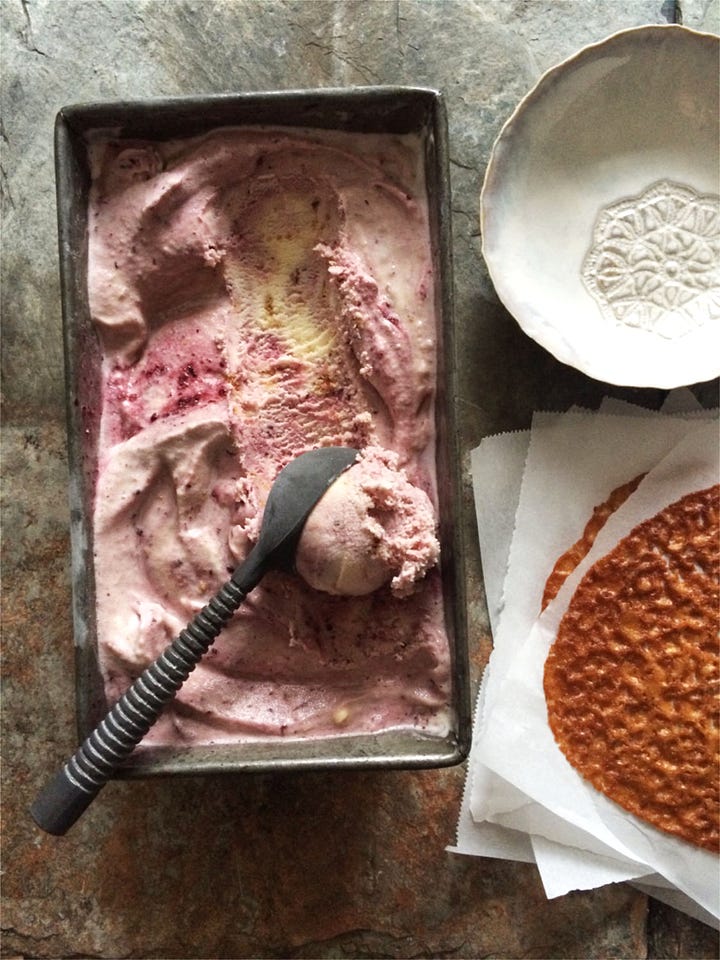
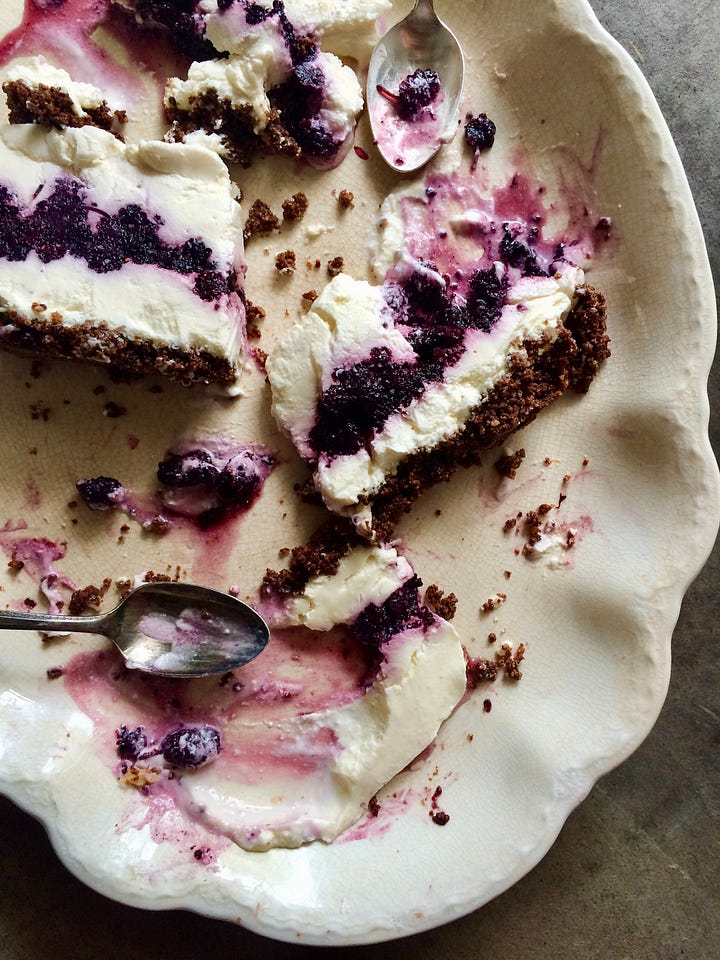

Picking the fruit by hand will produce the highest quality fruit and the longest shelf life. It's also the most labor intensive. You can lay a clean tarp and throttle branches to create a “mulberry shower” for volume, but you will need to sort unripe fruits, leaves, and a greater number of insects or debris using this method.
As I discussed proper hydration in this cantaloupe post, consider adding mulberries to your repertoire - they are 88% water! Mulberries are a treat, eaten straight from the tree, plump and sweet. They also make a delicious syrup or shrub, topping for granola or yogurt, made into vinegar, ice cream, or jam, or baked into muffins. Their soft stems do not need to be removed before cooking. You may also freeze mulberries in the same way as wild blueberries, and enjoy them well past their season.
Purple-flowered raspberries
I have known of this delicate berry as thimbleberry, until - surprise - doing research for this very post! It is one of the few berry shrubs which has no prickles or thorns. I planted a colony of these shrubs on my upper hillside and they were sold to me as thimbleberry, an interchangeable name, though they are purple-flowered raspberries. No worry for purposes of today, however, as the fruits appear and taste quite similar.
Purple-flowered raspberries are native to the eastern US and grow in well drained soils in open woodlands. They grow as a multi-stemmed deciduous shrub, tend toward leggy, growing 4-9 feet tall. Plants spread via suckers to form large colonies. The maple-like leaves are palmate, large, and their surfaces are soft, with short fine hairs. Young branches are green; older branches are woody with pale brown bark that peels. Two-inch flowers have 5 petals that are usually deep pink, verging towards magenta. Fruits start out pale greenish, and once ripe - by late summer in this region - turn a pastel magenta. They are a soft, shallow cup berry containing many tiny seeds - a pleasant texture as they melt in your mouth. These berries are quite fragile, and therefore can’t be be cultivated as raspberries have.

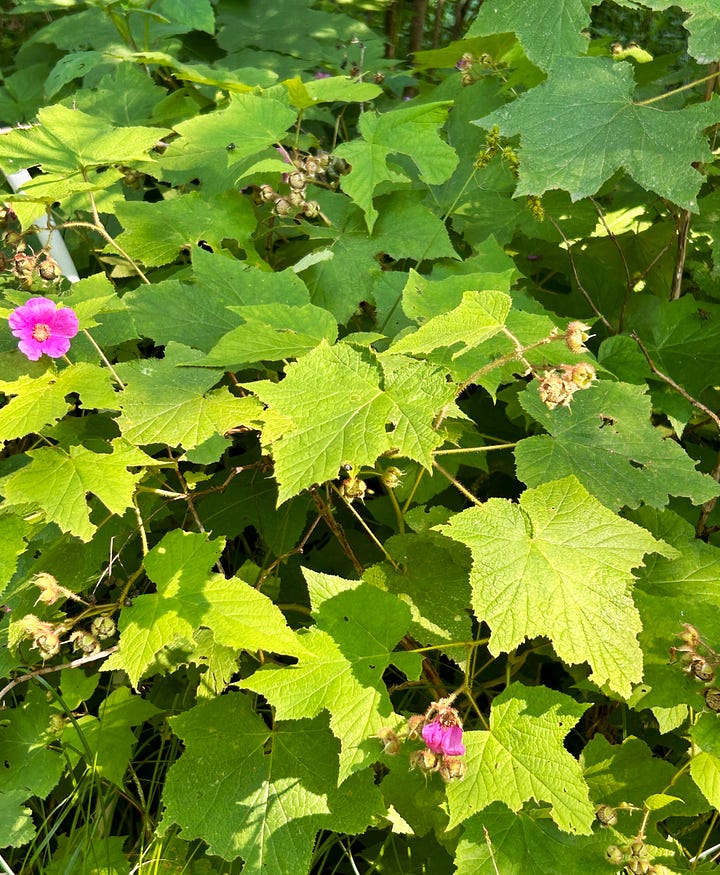
I haven’t been able to harvest purple-flowered raspberries in a large enough quantity to make jam or jelly, but they would be lovely prepared that way. They are an excellent straight-from-the-plant snack, as well as served in salads, over granola, or dehydrated and used as part of granola, or crushed into a fine powder and added to cocktails and baked goods.
Serviceberries
Also called juneberries or saskatoons, this tree berry ripens in late June here in the Hudson Valley. Serviceberries are native to North America and are a staple food to many indigenous peoples. The Amelanchier genus contains many species of serviceberries and it can be difficult to distinguish between them. All are edible! Trees are deciduous and can grow up to 25 feet tall. They have distinctly smooth gray bark and produce showy, star-shaped white flowers with five slender petals in the spring. I always look forward to its blooms, one of the earlier spring arrivals. Leaves are oval or elongated oval (lanceolate), and any have consistently fine serrated edges. Fruits grow from stems and are blueberry sized - first red, then ripening to purple. They taste like cherry-meets-blueberry with hints of almond.
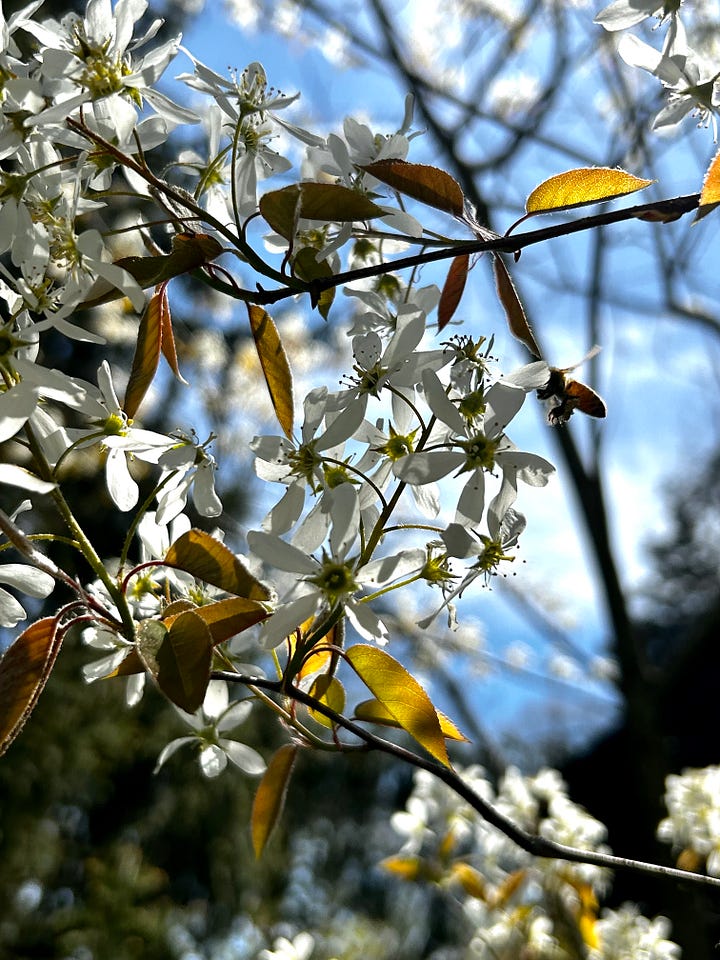
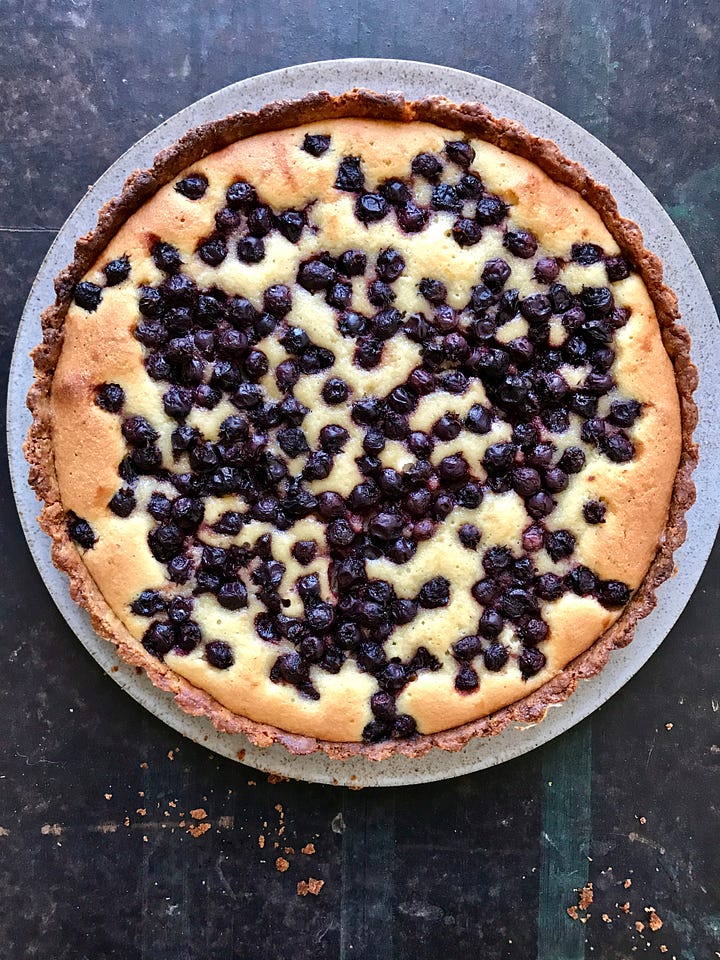

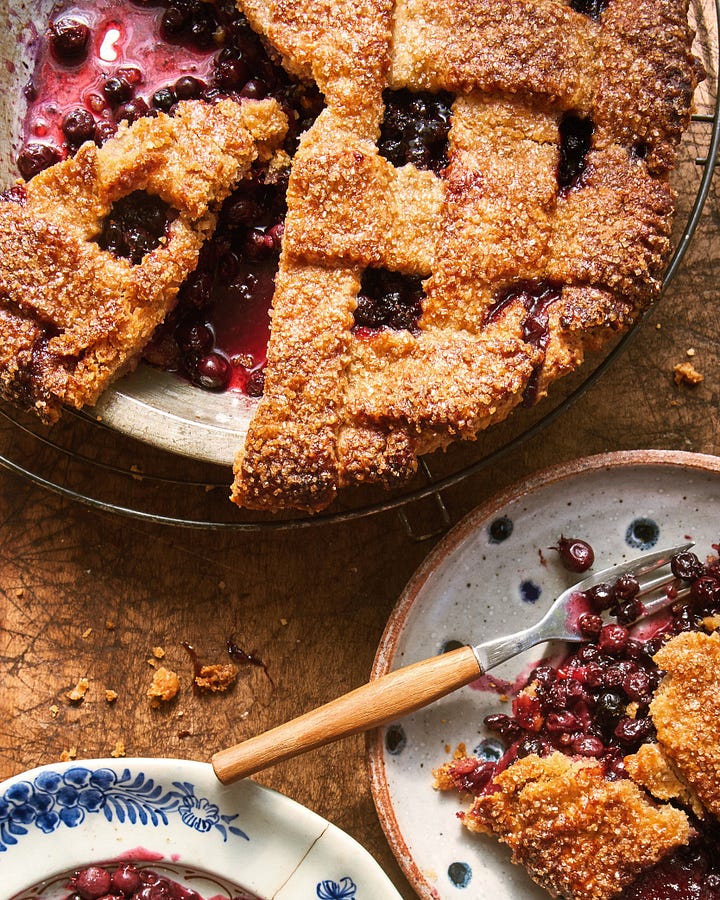
In native cultures, serviceberries are integral in making pemmican (wasná), an energy-packed pressed bar incorporating meat, fat, and (often dried) berries, which, once made, can be stored for a number of years. Serviceberries also make a great substitute anywhere you would use blueberries: raw, in salads, as a topping for yogurt or granola, and preserved as jam, jelly, or made into wine. Pies are also lovely! As I write this, it is past serviceberry season, but mark this for your foraging adventures next spring. There is always something to look forward to. ;)
Wineberries
The wineberry plant is an invasive shrub in the same genus as raspberries and blackberries. Wineberries were imported from Japan to North America in the late 1800s as an ornamental, and as a breeding stock for raspberries. They are a multi-stemmed shrub that produce arched, flexible, thorny canes that can grow up to 9 feet long. The canes and leaf stalks are covered in tiny, fine, dense red hairs. It is these hairs that make a quick differentiation from other berry-producing canes, as well as their silvery underleaf surfaces and bright red berries.
The plants create spiny, impenetrable thickets that reduce the ability of wildlife habitat and replace native vegetation, including native edible berry shrubs. They thrive in fallow fields, woodlands and many other habitats. The berries ripen mid-to-late July in this region and are shiny and vibrant red with hollow centers.
As with many berries, wineberry seeds are spread by animals. Seeds dropped on the forest floor germinate when falling trees provide light to the forest floor. Once established, wineberries can persist indefinitely, then reproduce once further disturbances occur.
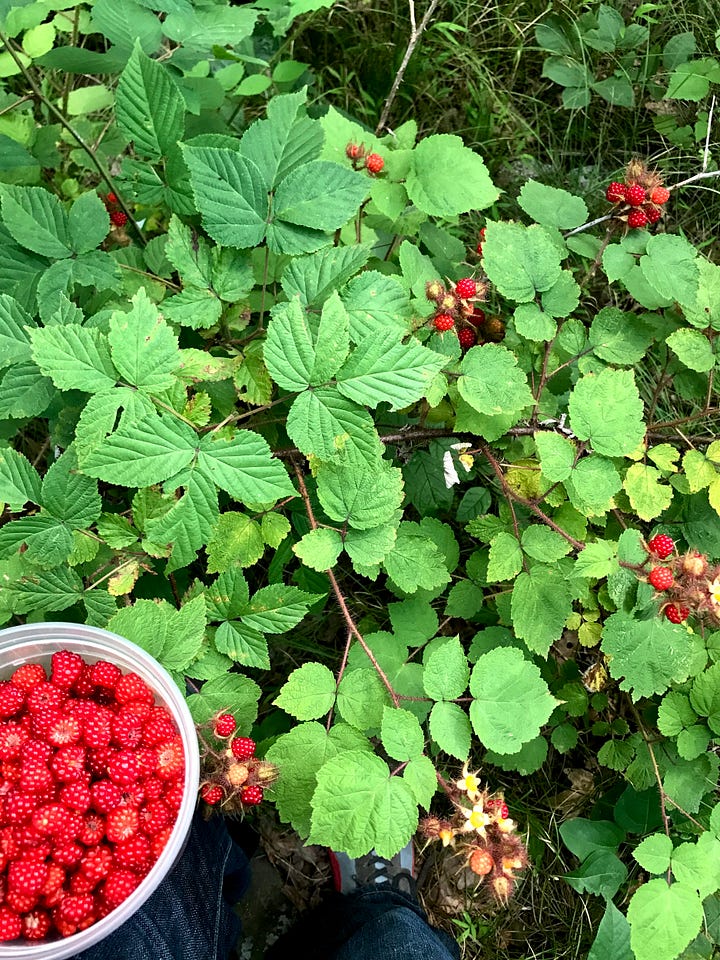

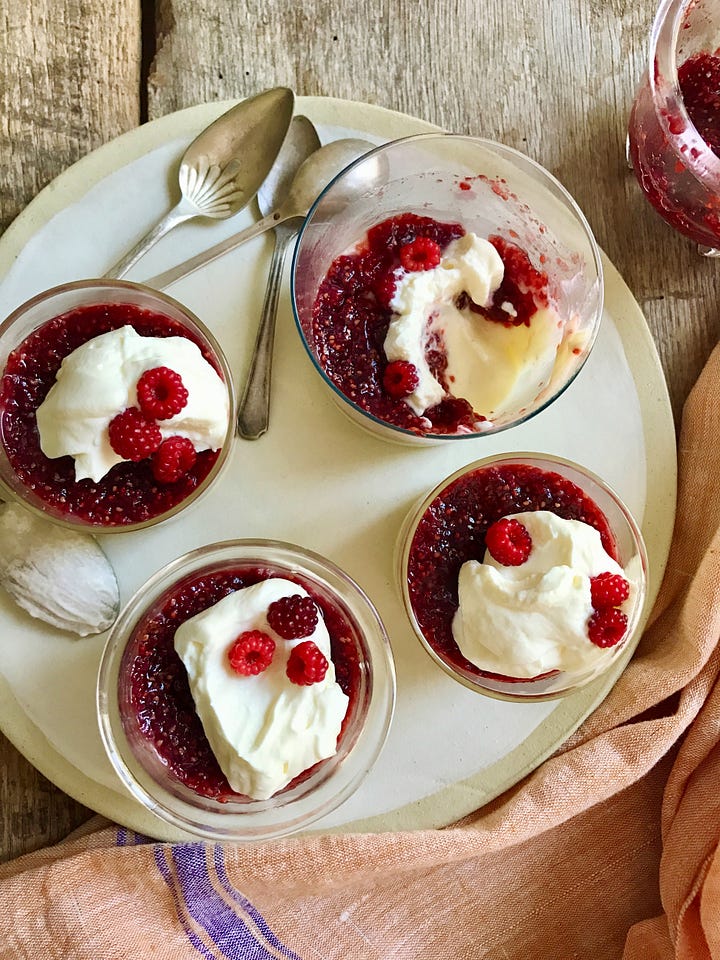
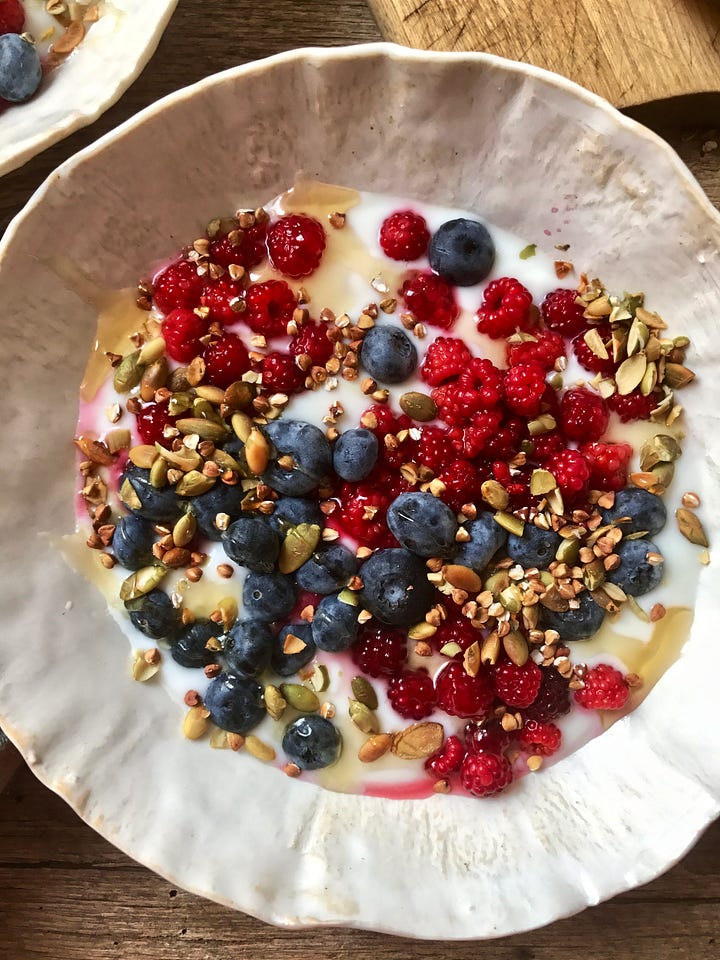
Wineberries are highly perishable and should be used within 3 days of harvesting. They are an excellent all-around berry, and everything I’ve made with them has turned out delicious.
✴︎ If you enjoy this post, thanks for clicking the ♥️, restacking it, or sharing it with another foodie or foraging fan! Doing so helps share my work with folks who don’t already know about Stories from Catbird Cottage. ✴︎
Looking for more?
Follow me on Instagram.
Do you love A Year at Catbird Cottage? If so, thanks so much for leaving a review on Amazon, whether you purchased it there or not. It makes it easier for others to find my book. Thank you!
Catbird Cottage is our home in the Hudson Valley, NY, where I teach cooking and gardening workshops, and host intimate dinners guided by the seasons. Drop a line to reserve a special meal or a delicious workshop with your friends.
My website contains a free recipe archive through the years, featuring fresh, seasonal ingredients that always bring wow to the table.
Enjoy my newsletter? Please forward it to a friend who might enjoy it too.




